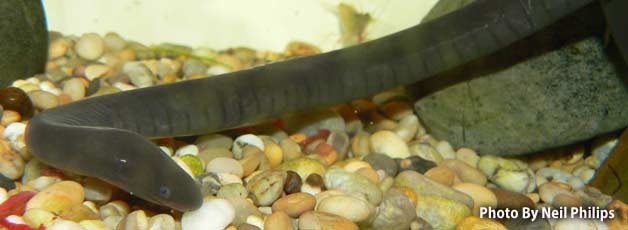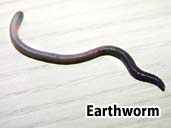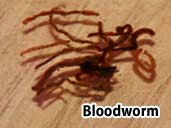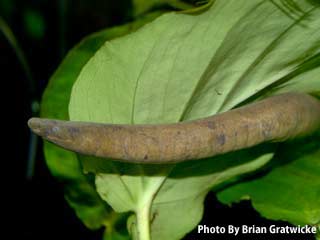
Aquatic Caecilian Care Sheet: Typhlonectes natans
There are over 155 known species of Caecilian, but this number may not be entirely correct, because Caecilians are one of the least known creatures on this earth. They spend a lot of time underground and have rarely been seen by man, so there may be many more species of Caecilian out there that have not been discovered yet.
Only a few species of Caecilian are commonly kept as pets. Some Caecilians have a burrowing lifestyle, while some are fully aquatic.
Here is the name of the most common aquatic Caecilian to be kept in captivity:
Common names: Caecilians, Rubber Eels, Black eels, Black Reef Eels, Sicilian Worms, Medusa Worms, Worm Fish and Eel Worms.
Scientific name: Typhlonectes natans
The name Caecilian is derived from caecus meaning ‘blind’ in Latin. The name is quite misleading as Caecilians are not actually blind, their eyes are just really small.
Caecilians belong to the familae Gymnophiona or Apoda, which has it’s own misinterpretation. The name is derived from the Latin ‘gymnos’ (naked) and ophis (snake), but the Caecilian is not a snake at all, being an amphibian rather than a reptile.
Description
Description: Caecilians are limbless creatures with small eyes and ring-shaped segmented folds all along their bodies. They have smooth skin, which is usually matt in dark colours like grey, green and black. Although they look similar to earthworms, snakes and eels, they are actually not related to any of these animals.
Size: The Caecilian Typhlonectes natans can grow up to 50 CM (20 inch), but other species may reach greater lengths than that.
Life span: (Captive) Aquatic Caecilians can live for about 4-5 years with appropriate care, but a greater age is thought to be possible.
Origin: Caecilians are found in South East Asia, Africa, South America, South China, New Zealand and Vietnam, but the aquatic Caecilian Typhlonectes natans is usually only found in South America.
Habitat: Aquatic Caecilians live in tropical areas in quiet waters with rocky bottoms. They breathe air so must return to the surface regularly to breathe. They also borrow in the mud along and below the river bed.
Captive Care
Temperament: Caecilians are docile and quiet pets, which are very interesting to watch. They are a little harder to keep than some amphibians, so are not recommended for someone who has not kept amphibians before.
They can live with other caecilians, but it’s not advised to house them with fish as they may eat them. Caecilians tend to group together and can often be seen sharing the same hide outs. 3-5 Caecilians will happily live together in a 10 gallon tank.
They can bite, but this is rare with appropriate handling.
Housing: Aquatic caecilians should be kept in an aquarium, with a filter and water heater. Care should be taken to allow your Caecilians room to breathe at the top of the tank- a few inches of air space should suffice.
The more space you give your Caecilians the more active they will be. A large aquarium will offer more space for your Caecilians to swim and explore than a smaller one.
A tight fitting lid is also required as Caecilians are excellent escape artists.
General aquarium gravel may be used at the bottom of your tank. Caecilians like to burrow, so fine gravel is best.
Cleaning: If you have a filter within your aquarium then you may not have to clean your Caecilian’s water as frequently, but without a filter weekly cleaning is necessary.
It is important to keep your caecilian’s tank clean at all times because of the bacterial build up created by the high temperatures and humidity. Caecilians can also carry parasites, so care must be taken to ensure these parasites stay at a containable level. Too many parasites can kill your caecilian.
Handling: Aquatic caecilians should not really be handled and should be treated as you would a fish. Use an aquarium net and place back in the water as soon as possible. A separate tank may be required for housing your Caecilians whilst the main tank is being cleaned.
Shedding: Caecilians shed their skin at regular intervals as they grow. The shed skin is nearly transparent and you will find it floating in the water of your terrarium. The skin should be netted out of the tank as soon as possible after shedding to keep the water clean.
Feeding
 |
 |
Caecilians should be fed daily with a varied diet of appropriately sized prey. They can be fed earthworms, insects, small fish, bloodworm and pelleted fish food.
If you are housing your Caecilian within your aquarium with other fish, be aware that small fish may be eaten. This is not always the case though, as some Caecilians can live in a aquarium with other fish, as long as they are fed appropriately and are not left hungry.
Your Caecilian's aquarium should contain:
 A place for your Caecilian to hide: All amphibians require somewhere to hide and may become stressed if this is not provided. In the case of Aquatic Caecilians, hiding places must be provided in the water. This could be a plant pot on its side or plenty of plants covering the bottom of the tank. Live plants can be used, but may be regularly uprooted by your caecilians has they borrow.
A place for your Caecilian to hide: All amphibians require somewhere to hide and may become stressed if this is not provided. In the case of Aquatic Caecilians, hiding places must be provided in the water. This could be a plant pot on its side or plenty of plants covering the bottom of the tank. Live plants can be used, but may be regularly uprooted by your caecilians has they borrow.
Bogwood makes a good natural looking addition to your aquarium and make great hiding places. Stones can also be used.
A change of scenery: Caecilians are very inquisitive animals and like to explore new surroundings. Once in a while change the layout of the terrarium; this will keep your Caecilian from becoming bored. You will notice once you put your Caecilian(s) back in the tank it will start to re-explore its new surroundings.
Water
Water in your aquarium should be changed regularly, especially if you are not using a filter.
The PH of the water does not need to be any ideal level, but it should stay consistent. A neutral PH should be easiest to maintain.
Heat
In an aquarium, you will need an aquarium heater to keep the water temperature are the required levels. Water temps need to be around 26-28 °C (78-81°F).
Care should be taken to ensure the water does not overheat.
Lighting
Caecilians do not need the edition of UV lighting, although you may find the live plants in your aquarium will die without any light. A fluorescent low UVB tube is ideal as it won’t give out any heat and will help the plants thrive.
Other questions about Aquatic Caecilians
This care sheet is a simple step-by-step guide to successful aquatic Caecilian keeping, but if you have any more questions or need more specific information about the keeping of Caecilians, please visit our forum. It is a useful resource where you can ask members to share good practice and also talk about your experiences of being a Caecilian keeper.

